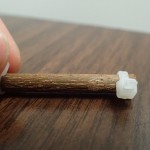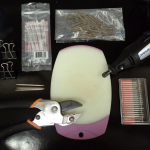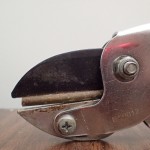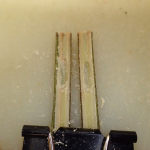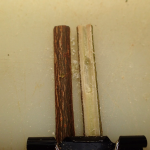Making Artificial Pith Galleries
Supplies:
– Anvil style pruner
– Small cutting board
– Rotary tool and attachments
– Sections of stem inter-nodes (~4-5cm long, ~0.4-0.5cm thick, sweetgum preferred for X. compactus)
– Cable ties
– Binder clips
– Toothpicks
1. Collect fresh stem sections, preferably 4-5cm long and 0.4-0.5cm thick.
2. Use pruners to cut stick open, down the middle lengthwise.
3. Secure each half of stick, cut side up, onto bottom edge of cutting board using binder clips.
4. Use rotary tool with the rounded grinding attachment (See photo) to create a gallery 1-1.5cm in length by removing pith. Make sure not to go past the pith of the wood. Do this on both stick halves so that it is a mirror image.
5. Use a toothpick to remove any excess sawdust.
6. Take one stick half and flip over, bark side up now, and switch to a fine-point grinding attachment (see photo) to drill the entrance hole for the beetle. This should be done in the center of the gallery.
7. Remove binder clips and join the two stick halves together, making sure they line up the original way prior to cutting. If done right, each gallery half should come together in the same place to form a full gallery. There shouldn’t be space in the cut between the two halves.
8. Use a cable tie to secure each end of the stick, continuing to hold it together while tightening. Cut excess off with pruner.
9. Freeze until ready to use and then autoclave to sterilize.
